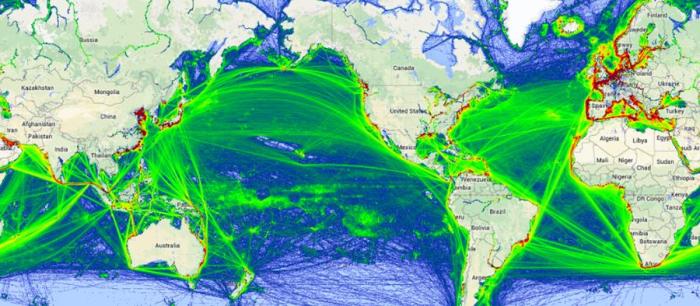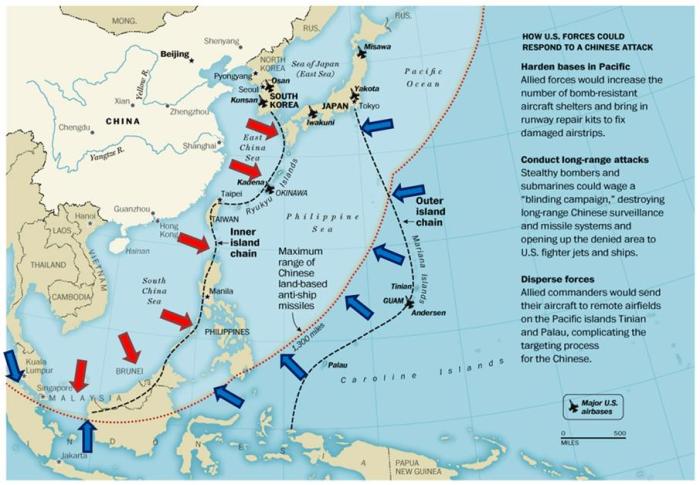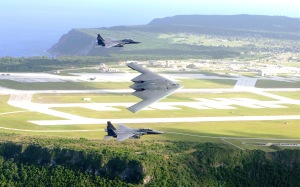“Salvo Competition.” “Third Offset Strategy.” “Air-Sea Battle.” “JAM-GC.”[1] The DoD is brimming with warfighting concepts, often anchored on technologies we have yet to fully develop. Many of the concepts depend on US technological superiority to dominate tactical-level engagements, though they do not necessarily demonstrate how victorious engagements lead to strategic success. While an exploration of “strategy” lacks the whiz-bang appeal of a postulated battle between widgets, distinct strategic architectures do exist and should be a topic of discussion – particularly with respect to China. Should peaceful instruments of American power fail, and the United States calls on force against the People’s Republic of China to protect vital national interests, victory will depend on our strategy more than our technology. This paper is a primer for current concepts which explain how war in the Pacific could look.
Only one of the approaches is the authors’ own, with others representing the work of other strategists. The point is not to claim them, but to contextualize them together in order to compare them. Each potential military response is presented as a strategic architecture and tied to its applicability against the People’s Republic of China (PRC). Each assumes that both nations will use incremental escalation to seek limited political objectives. Escalation to a nuclear exchange is possible but unlikely, as neither side counts among their objectives the destruction of the other political entity. Horizontal escalation – spreading the war away from a short, sharp battle to a prolonged regional conflict – is likely as neither side has a clearly decisive advantage and both have the ability to fight the other asymmetrically.
Inside-Out is a short, high intensity, tech-centric campaign to surprise, blind, and “dominate” an adversary. It is the heart of Air Sea Battle (and likely its successor, “JAM-GC”) where the “central idea…is to develop networked, integrated forces capable of attack-in-depth.” This architecture postulates a high-tempo attack against an adversary’s air defenses, command and control, and offensive systems. The appeal of this architecture is that it strives to repeat DESERT STORM-style victory. The downfall is that the Pacific is not the Middle East, and Beijing is not Baghdad. The geography and geopolitics of the Pacific mean that America will not be able to run a high-tempo campaign using short-range fighter aircraft to strike from nearby coalition bases, and the PRC has been optimizing its “anti-air raid” defenses for two decades while the USAF and USN have struggled to afford modernization, mired in two Middle Eastern wars.
During the present peace, outpacing a modern, centrally managed defense industry in a technological arms race is a challenge unlike the DoD has faced since the Cold War, and the American defense industrial base is far less responsive than it once was. There is substantial risk that the PRC will continue its campaign of cyber espionage to design countermeasures before advanced US systems even field. This has a disproportionate effect on the US’s current net-centric warfare approach because vulnerability in one system rapidly propagates to other systems.
In case of war, unless the US opts to seize the initiative offensively, the Inside-Out approach exposes US forces in the Pacific to a rapidly growing arsenal of long-range precision ballistic and cruise missiles. Should the PRC make the first move, forward forces will have to withstand a withering attack and reconstitute rapidly just to conduct defensive operations or receive follow-on reinforcements. The most dangerous aspect of an “Inside-Out” fight is that once it begins, each side is likely to locally blind the other via space and cyber attacks. This reduces both sides’ control over high-intensity combat operations and increases the risk of inadvertent vertical escalation against a nuclear-armed superpower whose redlines are difficult to determine. Where Inside-Out outshines other architectures is that it looks most like the preferred American way of war – a short, brilliant conflict. Where it induces the most risk is that it may create an attrition campaign where the US cannot sustain or afford enough battlefield “success” to achieve a favorable endgame.
Outside-In relies on a more classic “peel the onion” approach to dismantle the PRC’s “anti-access/area-denial” (A2/AD) capabilities prior to a more traditional campaign against strategic targets. Outside-In targets Chinese power projection capability, falling back or starting further afield to draw PRC forces out from underneath their land-based defense umbrella. This approach treats the vastness of the Pacific as US strategic depth rather than a liability by recognizing that the PRC needs to come out of the 12-mile limit to have any appreciable effect. Outside-In does not initially attempt to conduct significant operations against the Asian mainland, instead electing to protect regional allies and destroy Chinese military forces that attempt to operate beyond the protection of their mainland-based defenses.
This architecture takes advantage of the US military’s long experience with expeditionary operations while the Chinese have yet to demonstrate commensurate air and sea power projection operations. It also recognizes that the maritime terrain of the first and second island chains is not favorable to China. Outside-In could be a strategy of choice if the US political objective is to blunt PRC power projection – particularly beyond the first island chain. As Outside-In approaches the second-island chain it necessarily begins to look like Inside-Out, though on a timeline of our own choosing and after some PRC attrition.
The Hedgehog strategy is a long-term engagement strategy which builds regional allies who have sufficient military power to complicate the PRC’s strategic calculus. This has effectively occurred with Japan and South Korea in Northeast Asia, while enhancing the “spines” on the backs of nations like Vietnam, the Philippines, Indonesia, Malaysia, and Thailand could mitigate PRC aspirations in the South China Sea as it blunted Soviet expansion in Europe.[2] Hedgehogs do not need to be able to resist the PRC militarily by themselves, they only need to present an unpalatable “meal” for an expansionist China and diminish China’s ability to achieve goals through intimidation or isolation.
A successful Hedgehog strategy would involve groups of hedgehogs who do not have to act cooperatively. That means this strategy might involve either bilateral or multilateral relationships of lethally-equipped partners who together present sufficient capability to provide an unfavorable correlation of forces for the PRC; wherein their best defense is by a passive, rather than active, military posture.[3] It is unlikely that many (if any) of the potential hedgehogs would unambiguously align with the US, but enhancing ambiguity and uncertainty is in our interests if it compels the PRC to sustain a status quo that favors us. If successful, this approach could check China’s ability to intimidate southern neighbors into its sphere of influence and extend their maritime claims without challenge.
This is a deterrence strategy rather than a warfighting strategy and thus is a relatively low-risk project. Some form of partner building effort is a necessary precondition for success in either the Inside-Out or Outside-In strategies, because these strategies require a nearby basing architecture. Conversely, failure to invest in strong partnerships in Southeast Asia while reassuring existing alliances in Northeast Asia risks creating the perception of a US “paper pivot,” boosting PRC regional clout and reducing the confidence of key partners upon whose ports and airbases Inside-Out and Outside-In depends. A Hedgehog strategy requires re-investment in “low-end” export hardware by US defense industry to gain influence in a Pacific arms race that the US is currently ceding to competitors.
Distant Interdiction or Offshore Control is an overt long war strategy that exploits China’s massive dependence on foreign commodities. Referred to by the Chinese as the “Malacca dilemma,” Pacific topography creates natural choke points beyond the reach of PRC power projection. US air, naval and amphibious forces could selectively interdict vital commodities to inhibit the PRC’s war making potential and apply pressure to their domestic economy. This strategy can be executed with both lethal and non-lethal techniques, providing unique reversibility. Logistics interdiction is, by the Chinese’s own admission, one of their worst vulnerabilities.
The distant interdiction strategy is a long-term anti-commerce strategy that is conducted primarily outside the reach of Chinese power projection capabilities. It takes advantage of the fact that China is essentially an island nation, where over 96% of its commerce traffic goes by sea with no possible overland equivalent of similar capacity. Much of this commerce comes from outside the second island chain, making interdiction possible from well outside the reach of China’s formidable mainland defenses. Distant interdiction succeeds explicitly through horizontal escalation, expanding the geographical scope of any conflict far afield. It is highly asymmetrical, in that the PRC cannot execute a similar campaign against the United States, which has coasts and maritime trade routes not dependent on passage through Asian island chains.

Maritime Traffic Flow for 2014
(Image from MarineTraffic)
Strategic Interdiction is a variation of this strategy that forgoes most forms of commerce in favor of targeting only energy supplies, particularly oil and coal. That focuses US blockade efforts from waylaying potentially thousands of ships to mere hundreds, mostly coming through the Straits of Malacca. Strategic interdiction also postulates limited direct attack against difficult to defend targets such as petroleum refineries, pipelines, railway systems, and the strategic petroleum reserve to accelerate the effects of energy privation.
No-Man’s Sea (NMS) could be a deliberate denial strategy, but because it lacks a defined objective, it is more likely to be an effect of other strategies. Extended combat operations render large swaths of the South and East China Sea effectively unusable for either side. As a US strategy, it would exploit US anti-surface warfare capabilities to make Chinese home waters or near seas a mutual exclusion zone. The effects of NMS might also occur under any of the other strategic architectures and might result from a conflict of any length.
If deliberate, the purpose of such a strategy would be to truncate Chinese power projection and to execute an economic warfare campaign. The US can pen-up both Chinese military and commercial vessels, forcing China to expend military capabilities on operations to protect vital supply lines, while their merchant fleet sees the global market forced to reconstitute without them. The strategy would apply economic pressure to the PRC by denying access to the maritime commons entirely. The economic impact would entail significant collateral effects, making NMS similar in concept to the Strategic Interdiction or Offshore Control concepts but without the specificity designed into Strategic Interdiction. While the loss of China will hurt world markets, the loss of the world market could be catastrophic for the PRC.

Simultaneous Application of Anti-Access/Area-Denial Keeps US Out, China In
(Image from Global Balita)
The architectures are basically strategy outlines, with further development needed to actually tune them for warfare. There are significant differences in the time each requires to convert applied force into strategic effects. The faster any architecture attempts to work, the more it becomes dependent on technology – to include technologies that have not yet been demonstrated or fielded. The fastest, Inside-Out, is the most seductive because it appeals to our preferred ways of war and exploits the defense industrial base’s promotion of war as a contest between hardware rather than strategies. It also makes an assumption that the US can do sufficient damage to the PRC’s mainland while launching from aircraft carriers and land bases that are subject to intense attack.
On the other hand, the Hedgehog strategy allows the US to exert influence in a regional security competition where we are often seen as a preferred partner. In the middle, between the Hedgehog’s indirect approach and a short-sharp Inside-Out campaign, the other architectures can be used together for more modest cost and without as much high-end new-tech. These middle ways forgo technological compression – rife with potential for stalemate or unpleasant strategic surprise – in favor of geographic and temporal distribution. These architectures presume that any war with a superpower will be measured in months, not days, and waged across oceans, not seas. They exploit basic PRC weaknesses in terms of geography and vulnerable supply lines to force the People’s Liberation Army Navy and Air Force to fight under unfavorable conditions.
In a time of constrained resources, the Inside-Out approach may demand so much new-tech investment that it constitutes a bridge too far with a Congress demonstrably hesitant to upset the current way US forces are bought, built, and based. While all the architectures need significant reinvestment in air, sea, and counter-missile forces, Inside-Out’s postulated tech solutions may drive costs that simply price the US out of that approach. But the lack of absolute technological superiority doesn’t mean victory is impossible, it just implies the use of a different architecture.
While the potential diplomatic, economic, and financial ramifications of the interdiction architectures may seem like unique liabilities, any expectation that war versus the PRC could be strictly contained to a military contest seriously underestimates the PRC’s sophistication. No matter what architecture is pursued, a military contest with the PRC would be complex, costly, and have significant economic consequences across the globe. Strategic architectures that consider geography, time and distance assets rather than liabilities should better allow the US to pull apart and separately engage PRC centers of gravity in pursuit of limited objectives.
Col. Mike “Starbaby” Pietrucha was an instructor electronic warfare officer in the F-4G Wild Weasel and the F-15E Strike Eagle, amassing 156 combat missions, and took part in 2.5 SAM kills over 10 combat deployments. As an irregular warfare operations officer, Colonel Pietrucha has two additional combat deployments in the company of US Army infantry, combat engineer, and military police units in Iraq and Afghanistan.
Lt. Col. Jeremy “Maestro” Renken is an instructor pilot in the F-15E Strike Eagle, amassing 170 combat missions in three combat deployments to OIF and OEF. He is a graduate of the USAF Weapons Instructor Course and recently returned from AFCENT where he contributed to the design of the counter-ISIS air campaign.
The views expressed are those of the authors and do not necessarily reflect the official policy or position of the Department of the Air Force or the US Government.
[1] Joint Concept for Access and Maneuver in the Global Commons (JAM-GC, pronounced “jam gee see”)
[2] The Wolverine Strategy is a variation on hedgehog, where the partner nation has significant local military power. Where a hedgehog is hard to digest, a Wolverine is dangerous to go near.
[3] The PRC will likely see their own use of military force as “defensive,” to include pre-emptive attacks on US or coalition forces. The use of “defensive” language by the PLA does not imply reactive.




Pingback: Essay: Strategies That Matter — One Size Fits None - USNI News